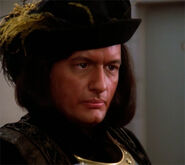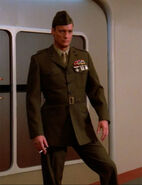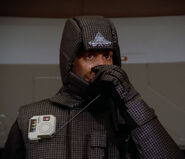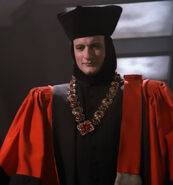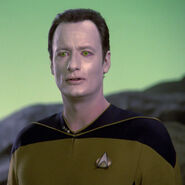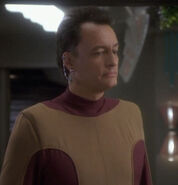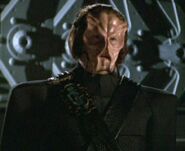Q was a highly powerful entity from a race of omnipotent, godlike beings also known as Q.
History
Q appeared to the crews of several Starfleet vessels and outposts during the 2360s and 2370s. As a consequence, all command level officers in Starfleet were briefed on his existence thereafter. One such briefing was attended by Benjamin Sisko in 2367. (DS9: "Q-Less") Q typically appeared as a Humanoid male (though he could take on other forms if he wished), and was almost always dressed in the uniform of a Starfleet Captain. (VOY: "Death Wish")
In every appearance, he demonstrated superior capabilities, but also a mindset that seemed quite unlike what Federation Scientists expected for such a powerful being. He had been described, in turn, as "obnoxious," "interfering," and a "pest". However, underneath his acerbic attitude, there seemed to be a hidden agenda to Q's visits that often had the best interests of Humanity at their core.
- "Either leave or finish us!"
- "Temper, temper mon capitaine, I'm merely trying to assist a pitiful species."
- - Captain Picard and Q (TNG: "Encounter at Farpoint")
On a planet called Brax, he was known as "The God of Lies". (DS9: "Q-Less")
In the 22nd Century, Q had "some dealings" with the El-Aurian, Guinan. These encounters resulted in strong antipathy between them. (TNG: "Q Who")
When temporarily rendered Human by the Q Continuum, Q claimed to possess an IQ of 2005. (TNG: "Deja Q")
Picard and the Enterprise-D
Trial
Q was first encountered by the Federation when he appeared aboard the USS Enterprise-D in early 2364. He warned the crew of the Enterprise that Humanity should return to their home Star System or be destroyed.
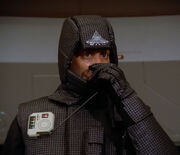
Q appearing as a soldier of the Third World War
When he encountered resistance, Q placed Humanity on trial, with Jean-Luc Picard and his command crew as representatives. Q accused Humanity of being a "dangerous, savage child-race." Picard managed to strike a deal with Q, however, and submitted to a test of conduct to prove that Humanity had evolved beyond its previously savage state.
The Enterprise's mission to Farpoint Station served as this test. The Starfleet crew sufficiently proved their evolved state of being by discovering and assisting a Spaceborne entity that had been coerced by the Bandi to take the form of a Starbase. Q disappeared, but promised the crew they had not seen the last of him. (TNG: "Encounter at Farpoint")
Game
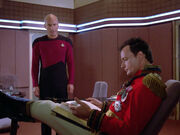
Q explaining to Picard that how Humans respond to a game tells more about them than a direct confrontation
The next time Q appeared on the Enterprise later that year, he created a bizarre and deadly "game" for the ship's crew, in order to demonstrate that he had given Commander William T. Riker Q-like abilities. His motives for this were that Humans had a desire to grow and explore, which the Q did not have or understand. Q wanted Riker to join the Continuum so they could understand and possess this desire because, if they did not, Humanity could one day surpass the Q.
Q and Picard settled on a bet that if Riker rejected his offer, the Q would leave Humanity alone forever. Ultimately, Riker rejected those new powers, and Q was forced back into the Continuum. (TNG: "Hide and Q")
Because of those actions, Q was asked to leave the Q Continuum. (TNG: "Q Who")
Guide
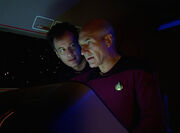
"Do we stay out here years? Decades?"
In his third appearance in 2365, Q presented himself as homeless, and expressed an interest in joining Picard's crew, his reason being that Humanity would eventually push into uncharted territory and would need a guide, as they were ill-prepared to face what they would find. Q even offered to renounce his powers to prove that his offer was genuine. However, when Picard vehemently declined (inspired by believing that Humanity could handle any threat), Q hurled the Enterprise into the path of a Borg cube. Ultimately, Picard had to beg for Q's help in escaping from the pursuit of the Borg ship. (TNG: "Q Who")
In that encounter, Q alluded to a past association with Enterprise Bartender, Guinan. Guinan declined to elaborate on the nature of her relationship, other than to express an extreme dislike for Q. Based on Q's reactions, the sentiment seemed mutual. (TNG: "Q Who")
Being Human
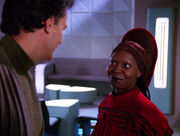
Powerless, Q meets Guinan in Ten Forward
In 2366, Q was stripped of his omnipotence and immortality and transformed into a Human by the Q Continuum, as punishment for his irresponsibility. He sought refuge on the Enterprise, and requested asylum and protection from the beings in the universe whom he had tormented. Although Captain Picard and the rest of the crew were unconvinced of the sincerity of Q's plea (and indeed suspected that the entire situation was merely an elaborate prank), Picard agreed to provide Q temporary asylum. Although not a scientist, Q provided theoretical guidance for Geordi La Forge's analysis of Bre'el IV's moon, which was in danger of colliding with its planet of Orbit. During that time, Data was assigned to watch Q, and Q gained an unusual perspective on Humanity and its condition from observing Data, in turn. However, after a Calamarain attack nearly destroyed Data (who risked his life to protect Q), Q resolved to leave on a shuttle, allow the Calamarain to kill him, and prevent further risk to the Enterprise crew. Another Q intervened at that point, acknowledged Q's selfless act, and restored Q's powers as a reward. In gratitude, Q corrected the orbit of the Moon and also gave a special gift to Data, his "professor of the Humanities" – a brief moment of genuine laughter. (TNG: "Deja Q")
Meeting Vash and acting as benefactor
In 2367, the Enterprise crew encountered a woman claiming to be the mythical Ardra of Ventax II. Her demonstrations of omnipotent power resembled those of Q, to the extent that the Enterprise crew speculated that she might be of the Q Continuum or perhaps Q himself. Picard pointed out that the woman's obsession with the Contract of Ardra was atypical of Q, and her powers were later proved to be the product of sophisticated technology, rather than any innate ability. (TNG: "Devil's Due")
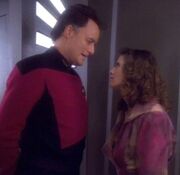
Q and Vash visiting Deep Space 9 in 2369
Later, in 2367, Q returned to the Enterprise to "properly" thank Captain Picard for his role in helping him regain his standing in the Continuum. At the time, Picard was meeting a past lover named Vash, whom he met on Risa, the year before. (TNG: "Captain's Holiday") Q resolved to teach Picard a lesson about love, and cast Picard, Vash, and the Enterprise command crew into an elaborate scenario styled by the ancient legend of Robin Hood. Q himself assumed the role of the High Sheriff of Nottingham. Ultimately, Picard learned and everyone was returned to the Enterprise. Intrigued by Vash, though, Q offered to take her on a journey of exploration to various archaeological ruins of the galaxy, and she accepted. To pay his debt to Picard, he promised that no harm would come to Vash. (TNG: "Qpid")

Q encouraging Amanda Rogers to use her Q abilities
In 2369, Q once again appeared aboard the Enterprise-D, this time to instruct Amanda Rogers, a seemingly Human female who developed Q powers during an internship with Doctor Beverly Crusher. Shortly after Rogers' birth, the Continuum had used a tornado to execute Rogers' parents, two Q who had assumed life as Humans on Earth, for being unable to resist using their powers while in Human guise. Although Q's petulant and acerbic attitude did little to ingratiate himself to Amanda, he eventually convinced her to go with him to the Continuum, to learn to use her new-found abilities. (TNG: "True Q")
A few months later, Q followed Vash back to the Alpha Quadrant, after the discovery of the Bajoran wormhole created a new avenue of travel between there and the Gamma Quadrant. Having had so much fun with Vash, Q wanted to continue exploring The Galaxy, but Vash wanted nothing to do with him. While the two were at Deep Space 9, mysterious power drains were believed to be Q's doing, but they were, in fact, due to an Embryonic lifeform that Vash had unknowingly brought back from the Gamma Quadrant. Q also had a brief confrontation with Commander Benjamin Sisko during his visit and disrupted an Auction that Quark and Vash staged in Quark's Bar. Although he was intrigued by Sisko hitting him, Q eventually got bored because "Sisko was so different than Picard". One might speculate that Q's actions were intended to ensure Vash's safety in regards to the promise that he made to Picard two years earlier. In the end, Vash and Q went their separate ways, though both eventually admitted to retaining a certain fondness for each other. (DS9: "Q-Less")
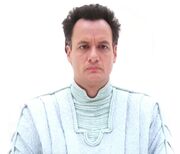
Q appearing to Picard as "God" in the afterlife
Later that same year, Q appeared to Picard when the latter was critically injured in a Lenarian ambush. Appearing as "God", Q told Picard that he had died because of his Artificial heart, and offered him the chance to return to the incident in his youth, which allowed him to relive the events leading up to his near-fatal injury and change history. Although Picard was successful in changing history, he eventually realized that the event – and his previous nature as an arrogant, brash young man – was a part of his identity, and had helped mold him into the successful Starfleet officer that he became. Although he was uncertain as to whether the experience had been real or simply a vision, Picard was grateful for Q's revelation. (TNG: "Tapestry")
Never-ending trial
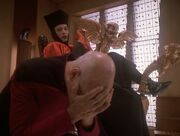
Q congratulating Picard for his method of collapsing the anomaly
In 2370, Q returned to the Enterprise to continue the trial against Humanity. Claiming that the seven-year-old trial had never actually ended, Q proclaimed Humanity guilty of "being inferior" and informed Picard that his race was to be destroyed. He sent Picard traveling through time to his own past and present, as well as to a potential future. In all three time periods, Picard was presented with a temporal paradox, in the form of an eruption of Anti-time in the Devron system. In that paradox, Picard himself was responsible for the creation of the anomaly, which propagated backwards in normal time (anti-time having the opposite properties of normal time), thus destroying Humanity in the past.
However, in addition to sending Picard jumping through time, Q also provided Picard with hints to understanding the nature of the paradox. Ultimately, Picard determined the solution and devised a way to close the anti-time anomaly in all three time periods. Following the success, Q revealed that the entire experience had been a test that was devised by the Continuum, and was aimed at determining whether Humanity was capable of expanding its horizons to understand some of the advanced concepts of the universe, including the potential of Humanity's own evolution – but helping Picard was his idea. Q promised to continue watching Humanity, and proclaimed that: "The trial never ends." (TNG: "All Good Things...")
Janeway and Voyager
Quinn
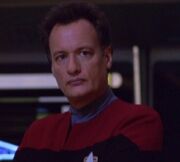
Q appearing on Voyager for the first time
In 2372, Q was sent by the Continuum to board the USS Voyager, whose crew had unintentionally released a renegade Q from confinement in a Rogue comet. When the other Q (later known as "Quinn") asked for asylum on Voyager in order to fulfill his wish to commit suicide (an act considered illegal in the Continuum), Q was permitted to represent the Continuum at a hearing to determine whether the requested asylum would be granted. Q argued that permitting a Q to commit suicide would cause unspeakable chaos and disorder – a profound irony, considering Q's own history as a prankster and renegade. (When confronted with his past deeds, Q commented that "[his] record has been expunged.")
Ultimately, Quinn's arguments prevailed, and he was made into a mortal being. Q himself was touched by Quinn's dedication and beliefs – Quinn had previously been an admirer of Q's, because of Q's propensity to stir controversy and cause disorder – and actually provided Quinn with the means with which to commit suicide. Q resolved to return to some of his old habits, and to encourage the Continuum to allow more chaos into their own order. (VOY: "Death Wish")
War
Following the death of Quinn, a massive Q Civil War broke out, as the forces of the status quo resisted the calls for change in the Continuum, by a faction led by Q himself. Seeking to end the conflict, Q devised a plan to mate with Kathryn Janeway, the Captain of Voyager, in order to create a new Q/Human Hybrid – a new breed of Q that would help bring an end to the civil war. Janeway, however, flatly refused.
Q then kidnapped Janeway and took her to the Continuum, where he again tried to persuade her, by explaining the nature of the conflict. However, Janeway again declined (though she openly sympathized with Q for his inability to understand love), and attempted to negotiate a truce between the two sides. Those negotiations failed, however, because the status quo faction refused to accept any terms other than surrender. They attempted to execute both Q and Janeway, but they were stopped by personnel from Voyager, with the assistance of Q female, an old flame of Q's. Q and the female Q were able to equip Janeway and the rest of Voyager's crew with Q weapons, which they were able to use to battle the opposing status quo faction.
Q then proposed mating with his old girlfriend (instead of with Janeway) and she agreed. The new child, nicknamed Q junior, became the first child born in the Continuum for millennia, and his presence brought an end to the civil war. (VOY: "The Q and the Grey")
Junior
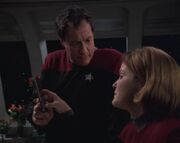
Q giving Janeway a PADD
Q's child, however, did not prove to become the perfect "savior" child that he was meant to be. Junior grew into a spoiled brat, and caused chaos and disorder. Q tried to briefly leave his son with "Aunt Kathy" aboard Voyager, and hoped that Janeway's "vaunted Starfleet ideals" would rub off on him. Q himself began to learn more about the role of being a parent (revealing that much of Junior's actions were not punished properly by Q). However, after spending years with the child, Junior only began to behave worse. As a result, the Continuum stripped his son of his powers, left him aboard Voyager, again under the care of Janeway, and told him to reform his ways within a week or Junior would be sentenced to spend eternity as an Oprelian amoeba.
Although Q was initially unimpressed by his son's progress, he devised a test of "Q-ness" to determine whether his son had improved his attitude. He masqueraded as a Chokuzan Captain and threatened Junior and his friend Icheb after they stole the Delta Flyer II from Voyager. Junior passed with flying colors, and offered to sacrifice himself to face the consequence of his actions, which had endangered Icheb.
However, the Continuum was not impressed by Junior's progress, and sentenced him to remain Human. Outraged, Q proclaimed that he would leave the Continuum if his son was not allowed to rejoin – the pair was a "packaged deal." "Begging for [Q's] return" as a deterrent to instability (Q earlier stated that he "holds them all together"), the Continuum acquiesced, on one condition – that Q retain eternal custody of the boy. Grateful for her assistance, Q provided Janeway with a map to a shortcut that would shave three years off Voyager's journey home. Janeway asked Q why he didn't send them all the way back to Earth, and his response being that it would be setting a bad example for his son if he did all the work for them. (VOY: "Q2")
Q's appearances
Appendices
Appearances
- TNG:
- "Encounter at Farpoint" (Season 1)
- "Hide and Q"
- "Q Who" (Season 2)
- "Deja Q" (Season 3)
- "Qpid" (Season 4)
- "True Q" (Season 6)
- "Tapestry"
- "All Good Things..." (Season 7)
- DS9:
- "Q-Less" (Season 1)
- VOY:
- "Death Wish" (Season 2)
- "The Q and the Grey" (Season 3)
- "Q2" (Season 7)
Background information
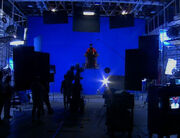
The filming of a Q scene from TNG series finale "All Good Things..."
Q was played by actor John de Lancie.
The character of Q was thought up by Gene Roddenberry, as a way to help fill out the events of "Encounter at Farpoint" from a one-hour to two-hour running time. (Star Trek: The Magazine Volume 2, Issue 12, p. 28) The name "Q" was chosen by Roddenberry, in honor of an English Star Trek fan, Janet Quarton. She was the first president of the UK Star Trek fan club, and Roddenberry and many others spent time at her home, in the Scottish highlands. (Star Trek Encyclopedia 2nd ed., p. 392; [1])
Immediately after Gene Roddenberry invented the character of Q, the other members of the TNG preproduction staff realized it was very reminiscent of the character Trelane from the TOS episode "The Squire of Gothos". "We're all looking at each other, saying, 'It's Trelane [from the original series] all over again,'" remembered David Gerrold. "We all hated it, and very gently suggested to Gene that it wasn't very good. Of course, this fell on deaf ears. He said, 'Trust me, the way I'll do it, the fans will love it.'" (The Fifty-Year Mission: The Next 25 Years, p. 67)
In an interview, John de Lancie likewise drew parallels between Q and Trelane, believing Gene Roddenberry had explored his storehouse of effective creations in writing The Next Generation and had found one that would turn out to be highly successful again in TNG. [2] In another interview, de Lancie said that, upon thinking of ways to describe Q's character, he had remembered a famous quote made about Lord Byron: that he was "mad, bad, and dangerous to know." (Star Trek 25th Anniversary Special)
Minimal makeup was used for the character of Q. "We always defined Q with a little eye makeup and a little lip color, just to make him stand out," recalled Makeup Supervisor Michael Westmore. (Star Trek: The Magazine Volume 2, Issue 12, p. 26)
Production Designer Herman Zimmerman was influential in the depiction of Q as a judge presiding over a courtroom. In the script of "Encounter at Farpoint", Q seemed to be floating in that area, though none of the production crew could figure out precisely how to show the character floating without resorting to visual effects for every one of those shots. Ultimately, Zimmerman suggested putting John de Lancie on a camera crane and bringing him into the courtroom out of a black hole, which was exactly how Q's arrival in that scene was shot. (Star Trek: The Magazine Volume 2, Issue 12, p. 30)
The depiction of Q in "Encounter at Farpoint" turned out to be extremely popular. Yar actress Denise Crosby commented, "The character of Q, and the way John de Lancie was playing it, was really interesting." Noted Rick Berman, "I think [Q] was certainly the most memorable element of that opening episode." "Encounter at Farpoint" Director Corey Allen remarked, "Q was so clearly a wonderful idea of Gene [Roddenberry]'s, about the questions we all ask ourselves; he was the interrogator that each of us carries on our shoulder." Herman Zimmerman observed that his idea of having Q arrive in the courtroom on a camera crane "worked very well." (Star Trek: The Magazine Volume 2, Issue 12, pp. 19, 28 & 30)
Although a first draft script of TNG Season 1 episode "Hide and Q" that Maurice Hurley penned was substantially rewritten by Gene Roddenberry, the character of Q still intrigued Hurley thereafter. He thought of Q as an unreliable god and subsequently intended for the character to feature in a story arc through the second season. Due to a writers' strike, though, Q was only brought back in the Season 2 episode "Q Who" before Hurley left the series. (Star Trek: The Magazine Volume 2, Issue 12, pp. 52 & 53)
Rob Bowman, who got an opportunity to direct John de Lancie as Q in "Q Who", enjoyed the experience, finding that de Lancie was easy to direct in the role. "He really had a grasp of the peculiarities of that character," Bowman remarked. (Star Trek: The Magazine Volume 2, Issue 12, p. 95)
Although Q was a recurring character over a relatively long time, he was used sparingly by the Star Trek producers, in case fans tired of him. Gowron actor Robert O'Reilly once likened these circumstances to his own situation, regarding his portrayal of Gowron. (The Official Star Trek: Deep Space Nine Magazine, Vol. 16, p. 22) Writing staffer Ronald D. Moore commented, "Q was a fascinating character, but I thought that he should be carefully rationed through the series. I thought if you played him about once a season, that was the most you wanted to use him." (Star Trek: The Official Starships Collection, issue 90, p. 17)
Devising Q stories challenged the writing staff of Star Trek: The Next Generation, due to the character's omnipotence. Q couldn't be made completely into an adversary, as he could simply wipe all the protagonists out of existence. The fact he was intended to be all-powerful also raised the question of why he even bothered with Humans and their allies. Both Ronald D. Moore and Jeri Taylor found it difficult to write for the character, though Moore also regarded doing so as "fun" because Q's extreme powers allowed the writers a wide variety of stories they could feature him in. (Star Trek: Communicator issue 113, p. 68)
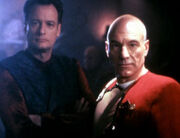
John de Lancie with Picard actor Patrick Stewart during filming of TNG: "Tapestry"
Following Q's appearance in "Q-Less", the possibility of him making another visit to DS9 was dismissed by Ira Steven Behr, when he remarked, "I don't forsee Q being back on the show. To me, his relationship with Picard was gold. And I don't think we can top it." (AOL chat, 1997) Ron Moore agreed, "The secret to Q was the Q and Picard relationship. Q was in love with Picard, for some reason. That was the underpinning of the relationship, which was why, when he came to Deep Space Nine, he wasn't as effective a character. The weird love affair that he had going with Jean-Luc made that whole thing work, and it made 'Tapestry' work, and ultimately it made 'All Good Things...' work." (Star Trek: The Official Starships Collection, issue 90, p. 17)
Q was originally rumored to make an appearance in Star Trek: Insurrection. However, Michael Piller put those rumors to rest. (AOL chat, 1997)
In 2002, Q placed eleventh in TV Zone's list of the top twenty science fiction television villains, along with several other Star Trek characters; the Borg Queen was second, Dukat was fourth, Weyoun was eighth, and Seska was nineteenth.
Along with Quark, Morn and Evek, Q is one of only four characters to appear in all three Star Trek series based in the 24th century: Star Trek: The Next Generation, Star Trek: Deep Space Nine, and Star Trek: Voyager. Of these four, Q is the only one who did not appear in VOY: "Caretaker".
Of the twelve Star Trek episodes featuring Q, eight of them use the letter "Q" in the title, often forming a pun.
Q was the first character to ever use the word "trek" in a Star Trek film or episode, which he does in the Star Trek: The Next Generation series finale, "All Good Things...". However, Zefram Cochrane is the only character to utter the phrase "star trek", doing so in Star Trek: First Contact.
- Locations "created" by Q:
- The post-atomic horror (2079) (TNG: "Encounter at Farpoint", "All Good Things...")
- The planet of the animal things (TNG: "Hide and Q")
- Sherwood Forest (TNG: "Qpid")
- Starbase Earhart (TNG: "Tapestry")
Apocrypha
According to Q in the String Theory books, omnipotent beings were actually rather fond of games of choice and chance, as it was only under those conditions that beings such as Q could feel the thrill of not being in total control.
Besides the character of Trelane having been an inspiration on the conception of Q in reality, they were both featured in the novel Q-Squared, in which Trelane was actually described as a "child" member of the Q Continuum (Even implied to be Q's own illegitimate son). When The Original Series was re-digitalized, Trelane's character was supported during one particular scene by a background character using added-in imaging of John de Lancie who, though he never spoke, was confirmed in the producer's commentary to be Q. Given that a relation between the two was never fully explored, and that many of the re-digitalized series' changes were met with disapproval by fans, the canonicity of that change was questionable.
The reason for Q's original interest in Picard in particular was explained in the novel, The Buried Age, which also revealed that he chose to call himself 'Q' as he felt that his original choice of 'The Inquisitor' would be too complicated for humans to say regularly, speculating that, if ever asked why he called himself 'Q', he would reply "Because U will always be behind me".
The audio play, "Spock Vs. Q: The Sequel", suggested that there was at least one individual "above" Q, naming herself "Petunia", who, in the play, seemed to have taken Q's powers and placed him, together with Spock, on an asteroid.
After alternate reality Spock melded with Q in the 2014 comics series The Q Gambit, he received one of the Bajoran Prophets and became even more powerful than he had been before.
Q and the Q Continuum appeared in the following non-canon works:
- Audio:
- Novels:
- Comics:
- "All Good Things..."
- DC TNG volume 1:
- #3: "Q Factor"
- #4: "Q's Day"
- #5: "Q Affects!"
- DC TNG volume 2:
- #33: "The Way of the Warrior"
- #34: "Devil's Brew!"
- #35: "The Dogs of War"
- #79: "Artificiality"
- #80: "The Abandoned"
- Annual #1: "The Gift"
- Star Trek Unlimited #7: "An Infinite Jest"
- Star Trek: Ongoing:
- Games:
External links
- [3]
- Q at Memory Beta, the wiki for licensed Star Trek works
- Q (Star Trek) at Wikipedia

